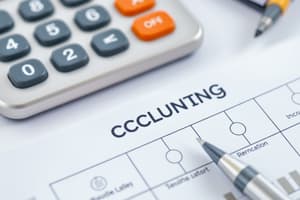Podcast
Questions and Answers
A business owns a building valued at $500,000, owes $200,000 on a mortgage, and has $50,000 in cash. What is the net worth of the business?
A business owns a building valued at $500,000, owes $200,000 on a mortgage, and has $50,000 in cash. What is the net worth of the business?
- $250,000
- $750,000
- $700,000
- $300,000 (correct)
Which step in the accounting cycle primarily involves verifying the equality of debit and credit balances?
Which step in the accounting cycle primarily involves verifying the equality of debit and credit balances?
- Preparing financial statements
- Posting to the ledger
- Journalizing transactions
- Preparing a trial balance (correct)
A business purchases office supplies with cash. Which source document would be used to record this transaction?
A business purchases office supplies with cash. Which source document would be used to record this transaction?
- Receipt (correct)
- Invoice
- Debit note
- Credit note
Which of the following accounts is classified as a current liability?
Which of the following accounts is classified as a current liability?
A business receives an EFT payment from a customer for services rendered. How will this transaction appear on the business's bank statement?
A business receives an EFT payment from a customer for services rendered. How will this transaction appear on the business's bank statement?
Flashcards
Net Worth
Net Worth
Assets minus liabilities; what the business is worth.
Accounting Cycle
Accounting Cycle
The sequence of steps to record and summarise accounting transactions.
Source Documents
Source Documents
Original records that provide evidence of a transaction.
Journals
Journals
Signup and view all the flashcards
Capital
Capital
Signup and view all the flashcards
Study Notes
- EMS Accounting Formal Assessment 1 for Grade 9
- Total marks: 50
- Date: 10 February 2025
- Examiner: Ms. S Smit
- Moderator: Ms. Stemmet
Terminology and the Accounting Cycle Lessons
- Lesson 1: Net Worth and Accounting Cycle covers how to calculate Net Worth.
- Lesson 1: It also covers how to complete the Accounting Cycle.
- Lesson 1: Learn what source documents are for different transactions.
- Lesson 1: Learn the different journals used for different transactions.
- Lesson 2: Account classification requires defining different accounts
- Accounts to define: Capital, Drawings, Non-current assets and Current assets, Non-current liabilities and current liabilities, Income and Expenses
Bank Accounts and Source Documents Lessons
- Lesson 1: Bank accounts, learn to interpret a bank statement.
- Lesson 2: Source documents, learn to interpret a receipt and an EFT payment authorisation.
- It is important to review all activities in the textbook.
Studying That Suits You
Use AI to generate personalized quizzes and flashcards to suit your learning preferences.
Related Documents
Description
Comprehensive review of accounting principles for Grade 9, including net worth calculation and the accounting cycle. Covers source documents, journals, account classifications (assets, liabilities, income, expenses), bank statements, receipts, and EFT authorizations. Activities from the textbook should be reviewed.




